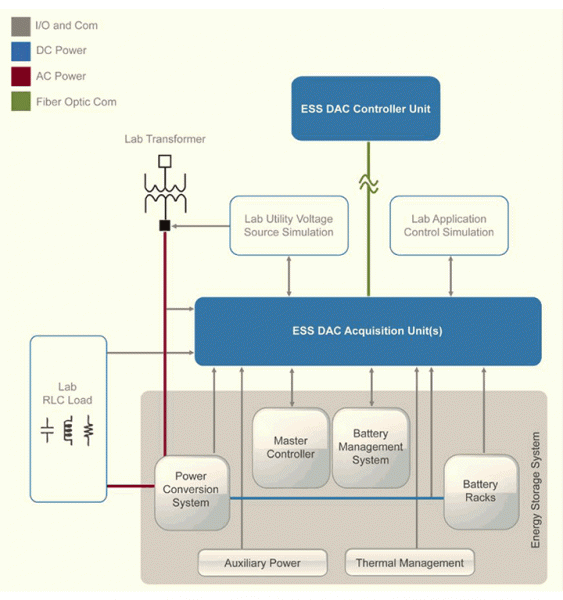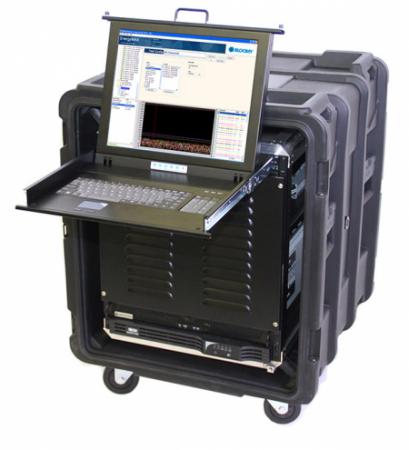Functional, Performance, and Applications Testing of Battery Energy Storage Systems
The Energy Storage System (ESS) Performance Test System is used to evaluate, test, and certify the performance of energy storage systems up to 2MW. The system is a configurable platform with over 200 channels of simultaneously measured AC and DC voltages and currents, environmental temperatures, airflow, and communications. Intuitive software provides real-time monitoring and analysis of power, energy and efficiency to adhere with industry standards. The test system interfaces hardware such as load banks, and controls the ESS to simulate utility applications such as peak shaving and frequency regulation.
- Power quality and energy efficiencies measured to IEC, EN, and IEEE standards
- Simulate utility applications such as peak shaving and frequency regulation
- Portable system for field testing
- Assists with IEEE 1547.1 testing for interconnecting distributed grid resources
- Helps verify response and accuracy of frequency regulation per FERC Order 755
- DNP3 and IEC 61850 communication protocols
- Generate standardized system performance reports
Energy storage systems (ESS) are an enabling technology for the future power grid. Largely consisting of advanced electrochemical batteries, ESSs increase the efficiency of large centralized power stations, incorporate renewable energy from solar and wind farms, and improve the reliability and cost of energy provided to consumers.
There is a lack of standards governing ESS performance and test. Present-day battery testing on new technology has outpaced the standards development process. To support the rapid evolution of energy storage technology, Bloomy has developed and continues to evolve an ESS performance test platform which can be used for standardized energy storage testing. The ESS Performance Test System is best for applications such as:
- Functional, performance, and life-cycle testing
- Utility application simulations
- Factory and site acceptance testing
Bloomy integrated the first generation ESS Performance Test System (previously known as the ESS DAC) into the Energy Storage Performance Test Lab at DNV-GL (formerly KEMA Power Test) in Chalfont, PA. A fiber optic interface was implemented from the main control unit to the secondary monitoring units. The secondary monitoring and control units interface to the lab transformer, loads, and the ESS components for control and test.

The following table outlines the common tests and measurements which can be performed by the system. Additional Measurements and tests can also be integrated into the system.
Common Measurements | Common Tests |
|---|---|
|
|
The following are typical configurations. Higher voltage and current ranges and customized channels are also available.
| AC Voltage | |
|---|---|
| 3-phase connection | Delta or Wye |
| Channel sets | 4 |
| Voltage range | 400 Vrms L-N, 800 Vrms L-L |
| Overvoltage withstand | 1000Vrms for 1sec |
| Surge withstand | 5kV for 100uS |
| Accuracy | 0.05% reading + 0.012% range |
| AC Current | |
| 3-phase connection | Delta or Wye |
| Channel sets | 4 |
| CT type | Rogowski Coils |
| Current range | 250 – 5000Arms |
| Linear accuracy | ± 1% |
| Phase angle | < 0.5° |
| Bandwidth | 14.5kHz |
| Isolation | 5kV |
| DC Voltage | |
| Channels | 4 differential |
| Voltage range | 0 - 1000V |
| Accuracy | ± 0.5% |
| Bandwidth | DC to 25kHz |
| Surge withstand | 5KV |
| DC Current | |
| Channels | 4 differential |
| CT type | Open loop hall effect |
| Current range | 200 – 2000Arms |
| Accuracy | ± 1% |
| Bandwidth | DC to 6kHz |
| Isolation | 5kV |
| Temperature | |
| Channels | 16 |
| Thermocouple types | J, K, T types |
| Accuracy | ± 0.5°C |
| Communications | |
| Supported protocols | Modbus, DNP 3.0, IEC 61850 |
The ESS Performance Test System application is based on the Bloomy EnergyMAX™ software platform and toolkits. The platform has two main components: the main application where engineers configure the system, calibrate hardware channels, and monitor ESS data; and the acquisition engine, which provides the data acquisition, communications, and synchronization capabilities at the hardware level. General software functionality includes:
- Test setup
- Channels
- Test type
- Arbitrary charge/discharge waveform (through communications)
- Triggering
- Test Execution
- General channel monitoring
- Real-time calculations (power, frequency, THD, flicker, etc.)
- Data storage
- Report generation
The power monitoring component utilizes the National Instruments Electrical Power Suite for power quality analysis, measurement, and protection for 50/60Hz systems. The following are the major features of the toolkit:
- Measure power quality and energy features to IEC, EN, and IEEE standards
- Harmonics (IEC 61000-4-7) and Flicker (IEC 61000-4-15)
- Phasor measurement unit (C37.118)
- Sag/swell/interruption with standard or custom levels (IEC 61000-4-30)
- Rapid voltage change with standard or custom levels (IEC 61000-4-30)
- Compatibility with the COMTRADE (IEEE 37.111) file format

